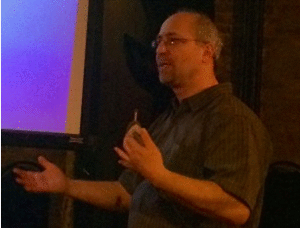What is shown? The upper left photo shows a metal mesh tubing. This is a stent. It’s about half an inch wide and a few inches long. This stent is inserted into a blood vessel to help keep the vessel open and the blood flowing (illustrated on the top right). The bottom photo shows the vessel in a patient who had an autopsy. In this case, the type of vessel is a vein. It is a large vein that drains the blood from the leg. The vein, is cut into smaller pieces to see what’s on the inside. You can see metal stent as a circle of dots that that presses up on the inside of the vessel. The inside of the stent is filled with yellow solid tissue. This is scar tissue. The vessel should have been open and and empty.
Did the scar tissue cause a problem? Yes. The vessel was completed blocked by the scar tissue, so it could not drain the blood from the leg. The left leg was swollen. There was blood return from the leg, but it was through smaller side veins, and not enough to keep the leg from swelling.
Did the blockage cause the patient to die? No. The patient did not die from this. He lived with a swollen leg. The swelling developed gradually over many years (see below).
Why was the sent placed? The stent was placed in the vein to keep it open. A blood clot had formed in the vein, blocking flow. The stent at first helped with that by opening up the vessel to allow blood flow back from the leg.
Why did the scarring happen? The scarring happened because, even after the stent was put in, more clot formed inside the vessel. The body’s response to a clot is to heal the clot by forming scar tissue. It is a natural response of the body to any clot that forms inside a vessel. The process of forming this scar took many years.
Does the scar means there was a problem with the procedure or with the stent? No, stents are not perfect. Any time “foreign” material (like metal) is put into the body, there is a known risk that the body will have a reaction to it. Also, this patient was already at risk for forming clots (see below). There is always a “risk-benefit” decision for any procedure. The thinking is like this: Without the procedure, the patient would have had blocked circulation in the legs. With the procedure there is the risk down the line that the stent could get blocked. The best decision was to do the procedure to help with the “immediate risk” to the patient from his own blockage the first time he had a clot.
What was the story here? This was an 18 year old man with a disease related to sickle cell anemia called with S-C disease. “S” stands for “Sickle”. “C” is a genetic variation of sickle cell anemia. These patients are typically a bit less sick than patients with sickle cell anemia but also have serious problems.
How did this patient die? This patient died from “Acute Chest Syndrome.” This is a condition that happens commonly in S-C disease. Here’s how it works: In S-C disease (just as in Sickle Cell Anemia), the red blood cells can clump and block the blood flow in many areas of the body. When that happens specifically in the bone marrow, parts of the bone marrow can die. The dead bone marrow leaks into the blood stream, travels up to the lungs, and the little clumps of bone marrow block the circulation there. This causes the patient to die. Unfortunately, many clinicians are not aware of this complication of S-C disease. This patient’s clinician did not consider this diagnosis.
How did the autopsy help? The autopsy helped the family come to terms with the loss. The family also chose to share the results with the treating physician which served to educate him about this condition. It was an empowering move by the family in a situation that was otherwise marked by helplessness. The specific finding of a blocked stent was incidental to the cause of death but facilitated a general discussion of the patient’s medical past.


